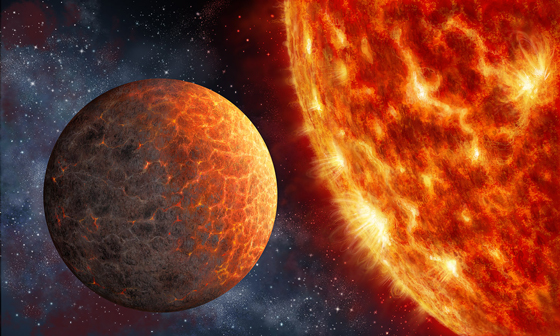
Astronomers have discovered a planet 219 light years away that may closely resemble Venus. Credit: Danielle Futselaar
A group of astronomers has detected what may be a close relative to Venus about 219 light-years away.
Astronomers using NASA’s Kepler Space Telescope discovered the planet, which is only slightly larger than Earth and orbits a low-temperature star called Kepler-1649 that’s one-fifth the diameter of the Sun.
Elisa Quintana, of the SETI Institute and NASA Goddard Space Flight Center and a member of the Kepler 1649b discovery team, said that the discovery of a planet similar to Venus is just as important as the pursuit of a planet close in characteristics to Earth.
“Many people are hung up on finding other Earths. But Venus analogs are just as important,” Quintana said in a statement. “Since new telescopes coming down the pike will allow us to probe atmospheres, focusing on both Earth and Venus analogs may help decipher why, in our Solar System, one planet allows life to thrive, and one does not, despite having similar masses, comparable densities, etc.”
The planet tightly embraces its dim home star, encircling it every nine days. The tight orbit causes the flux of sunlight reaching the planet to be 2.3 times as great as the solar flux on Earth, while the solar flux on Venus is 1.9 times the terrestrial value.
Isabel Angelo, a scientist from the SETI Institute in California, said the study of planets similar to the Venus analog Kepler 1649b is becoming increasingly important in order to understand the habitable zone boundaries of M dwarfs.
“There are several factors, like star variability and tidal effects, which make these planets different from Earth-sized planets around Sun-like stars.”
Venus is often called Earth’s sister planet, but in many ways it is not that close of a sibling.
Despite being about the same size as Earth and only 40 percent closer to the sun, Venus’ atmosphere and surface temperature are widely different from that of Earth.
While it remains unclear which aspects of Earth’s development were key in acquiring and maintaining a hospitable atmosphere, finding and characterizing both Earth and Venus analogs around other stars could shed light on the differences.
According to the study, the Kepler mission was designed to measure the frequency and size of extrasolar planets with the primary goal of detecting other Earth-sized planets that could potentially be habitable.
Ultimately Kepler has been successful in finding Earth-size planets in the habitable zones of their host stars, a super-Earth in a Venus-like obit.
The Keplar-1649 system also appears to host a Mars-sized planet around a cool, nearby M dwarf with incident bolometric flux levels similar to Mars, which would make this planet the first “exoMars” and would add to the small sample of potentially rocky planets transmitting in or near the habitable zone of nearby M dwarfs.
The study was published in The Astronomical Journal.




